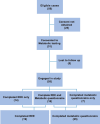Resting Energy Expenditure and Metabolic Features in Children With Septo-Optic Dysplasia
- PMID: 40104567
- PMCID: PMC11914970
- DOI: 10.1210/jendso/bvaf031
Resting Energy Expenditure and Metabolic Features in Children With Septo-Optic Dysplasia
Abstract
Context: Septo-optic dysplasia (SOD) is a major cause of congenital hypopituitarism and is known to be associated with overweight and obesity in up to 44% of children. Given the role of the hypothalamus in hormonal regulation, we sought to assess the association of resting energy expenditure (REE), appetite and physical activity with SOD.
Objective: To characterize REE and other metabolic features in patients with SOD and evaluate relationships with elevated body mass index (BMI).
Methods: Children with SOD above 5 years of age attending Perth Children's Hospital participated. A CosMED Q-NRG indirect calorimeter was used to calculate mean measure REE (mREE). This was compared with predictive REE (pREE) based on the Schofield equation to determine mREE/pREE quotient. A BMI z-score >1 was considered elevated. Parents/carers completed a questionnaire about pituitary function, the Hyperphagia Questionnaire and the Sleep Disturbances Scale for Children (SDSC).
Results: Twenty-six participants underwent testing (9 female, mean age 12.1 years) with 11 having elevated BMI and 15 with pituitary hormone deficiencies. Mean mREE was 1309 kcal/day (838-1732), mREE/pREE quotient was 88.8% ± 10.1. mREE/pREE quotient was similar in those with elevated BMI compared with normal BMI (83.3% ± 12.5 vs 92.1% ± 7.2, P = .068). Those with midline defects had a higher mREE/pREE quotient (91.8% ± 8.1 vs 80.4% ± 11.3, P = .026). Hyperphagia and SDSC scores were similar between BMI groups. Hyperphagia domain scores were higher in children with multiple hypopituitarism, pituitary structural defects, and normal septum pellucidum (P = .044, .042, and .033, respectively).
Conclusion: Children with SOD had lower mREE than predicted and hyperphagia scores were higher in those with biochemical or structural pituitary changes, suggesting that hypothalamic dysfunction could drive BMI elevation in SOD. Indirect calorimetry may be used to guide the management of overweight and obesity in SOD.
Keywords: hyperphagia; hypopituitarism; hypothalamic dysfunction; overweight and obesity; resting energy expenditure; septo-optic dysplasia.
© The Author(s) 2025. Published by Oxford University Press on behalf of the Endocrine Society.
Figures
References
-
- Cullingford DJ, Siafarikas A, Choong CS, et al. Genetic etiology of congenital hypopituitarism. In: Feingold KR, Anawalt B, Blackman MR, eds. Endotext. 2023:7‐12.
-
- Patel L, McNally RJ, Harrison E, Lloyd IC, Clayton PE. Geographical distribution of optic nerve hypoplasia and septo-optic dysplasia in northwest England. J Pediatr. 2006;148(1):85‐88. - PubMed
-
- Garne E, Rissmann A, Addor MC, et al. Epidemiology of septo-optic dysplasia with focus on prevalence and maternal age—a EUROCAT study. Eur J Med Genet. 2018;61(9):483‐488. - PubMed
-
- Ludwig PE, Lopez MJ, Czyz CN. Embryology, eye malformations. In: StatPearls. StatPearls Publishing; 2023. - PubMed
LinkOut - more resources
Full Text Sources

